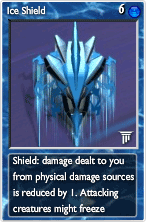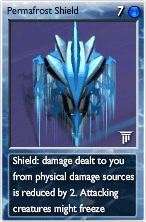Ice Shield
|
|
Contents
Overview
Ice Shield is one of the more powerful defenses in Elements. Like most shields, it reduces the damage from enemy creatures, but each time an enemy creature attacks, it has a 30% chance of being frozen for 3 turns. Because of this additional CC component, Ice Shield is an impressive card to fend off multiple enemy attacks.
General Use
Quick Facts:
- Each time an enemy creature attacks, it has a 30% chance of being frozen for 3 turns.
- In total, the freezing blocks 9/19, or 47% of all enemy attacks.
- Combining that with damage reduction, Ice Shield can block more than half of your opponent's attacks.
Like Fire Shield, Thorn Carapace, and Procrastination, Ice Shield is a form of creature control that activates automatically whenever a creature attacks. Each time a creature attacks, there is a 30% chance that it might get frozen for 3 turns. At a glance this percentage doesn't seem very high, and a player might think that Ice Shield is not very useful compared to the other auto creature control shields with higher chances of activation. However, if triggered, Ice Shield prevents a creature from attacking at all for 3 turns, and stops it from using its ability at the same time; the frozen creature might as well not exist. Combined with its damage reduction, Ice Shield is arguably one of the most valuable shields to wield during a battle.
Ice Shield seems more powerful than it looks, but how much damage does it actually block? Here is a mathematical analysis on Ice Shield (thanks to Delreich from the official forum). This is explained in a turn-by-turn manner:
| Turn # | % of damage taken (theoretical) | Detailed explanation |
| 1 | 100% of damage gets through. | (30% gets frozen, 3 turns wait on it). |
| 2 | 70% of damage gets through | (30% has 2 turns of wait, another 21% gets 3 turns of wait). |
| 3 | 49% of damage gets through | (30% - 1 turn; 21% - 2 turns; 14.7% - 3 turns) |
| 4 | 34.3% of damage gets through | (30% unfreezes; 21% - 1 turn; 14.7% - 2 turns; 10.3% - 3 turns) |
| 5 | 54% of damage gets through | (21% unfreezes ;14.7% - 1 turn; 10.3% - 2 turns; 16.2% - 3 turns) |
| 6 | 58.8% of damage gets through | (14.7% unfreezes; 10.3% - 1 turn; 16.2% - 2turns; 17.6% - 3turns) |
In short, Ice Shield blocks 9 out of 19 attacks; the block rate is roughly 47%. But that does not even count the damage reduction of 1 point, or 2 points when upgraded. Taking that into account, Ice Shield is an extremely powerful shield that blocks more than half of the enemy attacks using both a combination of damage mitigation and CC.
Ice Shield is one of the cards that become significantly more powerful when upgraded. Permafrost Shield, the upgraded form of Ice Shield, blocks 2 damage from every attack, as well as blocking 47% of all attacks by freezing. Such a shield significantly cripples an opponent's attacking power, and combined with some healing it can often render a player nigh invulnerable. Because of this, Permafrost Shield is often used in fully upgraded False God grinder decks.
Synergies
 To further reduce potential damage, Flooding | Inundation is often used as a support card for taking out creature rushes. Challenging players who are reliant on spawning multiple creatures with Fractal or Mitosis may find themselves starved for room as Flooding will only provide 5 maximum non-Water (and non-Other) creatures on the field, limiting the amount of damage one could have. On the flip side, players who have both Permafrost and Flooding are more likely to have creatures that can easily ignore such terrain changes, and thus enter play without fear of drowning. With only 5 cards on the enemy's field, Permafrost serves as a more important barrier.
To further reduce potential damage, Flooding | Inundation is often used as a support card for taking out creature rushes. Challenging players who are reliant on spawning multiple creatures with Fractal or Mitosis may find themselves starved for room as Flooding will only provide 5 maximum non-Water (and non-Other) creatures on the field, limiting the amount of damage one could have. On the flip side, players who have both Permafrost and Flooding are more likely to have creatures that can easily ignore such terrain changes, and thus enter play without fear of drowning. With only 5 cards on the enemy's field, Permafrost serves as a more important barrier.
 Shockwave | Shockwave can be used to instantly kill frozen creatures; with a shield that can freeze creature upon the enemy's turn, this cheap Air spell can be used to wipe out some of the most hefty monsters on the opponent's side. For 1-2
Shockwave | Shockwave can be used to instantly kill frozen creatures; with a shield that can freeze creature upon the enemy's turn, this cheap Air spell can be used to wipe out some of the most hefty monsters on the opponent's side. For 1-2 ![]() quanta, players can cast Shockwave on creatures that are frozen by the shield's effects, instantly killing the creature in question. However, players should also consider using Lightning or other CC effects against creatures that may bypass the shield with their abilities (such as Momentum).
quanta, players can cast Shockwave on creatures that are frozen by the shield's effects, instantly killing the creature in question. However, players should also consider using Lightning or other CC effects against creatures that may bypass the shield with their abilities (such as Momentum).
Other Cards With Synergy
Because of Ice Shield's expensive cost, semi-cheap water creatures, such as the Abyss Crawler, Toadfish, and even Chrysaora can pair up well in any type of deck that utilizes ![]() quanta. Conversely, for rainbow decks, other cheap or powerful cards (ranging from Lava Golem, for massive damage output in a rainbow, or Sanctuary, for anti-QC and healing in a stall) can benefit the shield more in other supportive ways. Players who intended on protecting their Ice Shield with Enchant Artifact should also consider using Trident for the added Water-Earth synergy; constant quanta denial with Trident's ability and a powerful defense can lead many enemy players unable to make the final push for their offense.
quanta. Conversely, for rainbow decks, other cheap or powerful cards (ranging from Lava Golem, for massive damage output in a rainbow, or Sanctuary, for anti-QC and healing in a stall) can benefit the shield more in other supportive ways. Players who intended on protecting their Ice Shield with Enchant Artifact should also consider using Trident for the added Water-Earth synergy; constant quanta denial with Trident's ability and a powerful defense can lead many enemy players unable to make the final push for their offense.
Conclusion
When it comes down to freezing creatures dead in their tracks, Ice Shield does it effortlessly time-and-time again; although its expensive cost may seem a bit of a deterrent, players can easily see how one of these chilling cards can break strategies within seconds upon its arrival.


